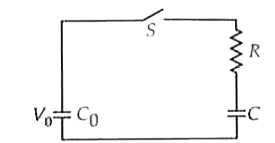A capacitor of capacity 20microF is charged upto 50V and and disconnected from cell. Now this charged capacitor is connected to another capacitor of capacitance C If final common potential is 20V then find the capacitance C.
To solve the problem step by step, we will follow the principles of charge conservation and the relationship between charge, capacitance, and voltage.
Step 1: Calculate the initial charge on the first capacitor
The charge Q1 stored in the first capacitor can be calculated using the formula:
Q1=C1×V1
where:
- C1=20μF=20×10−6F
- V1=50V
Substituting the values:
Q1=20×10−6F×50V=1×10−3C=1mC
Step 2: Set up the equation for the final common potential
When the charged capacitor C1 is connected to the uncharged capacitor C2 (with capacitance C), the total charge will be conserved. The final common potential Vf after connecting both capacitors is given as 20V.
The total charge after connecting the capacitors can be expressed as:
Qtotal=Q1=C1×Vf+C2×Vf
This can be rewritten as:
Q1=C1×Vf+C2×Vf
Step 3: Substitute known values into the equation
Substituting the known values into the equation:
1×10−3C=(20×10−6F)×(20V)+C×(20V)
Step 4: Simplify the equation
Now, simplifying the equation:
1×10−3=(20×10−6×20)+C×20
Calculating 20×10−6×20:
20×10−6×20=400×10−6=0.0004C
Thus, the equation becomes:
1×10−3=0.0004+C×20
Step 5: Solve for C
Rearranging the equation to isolate C:
C×20=1×10−3−0.0004
C×20=0.0006
Now, divide both sides by 20:
C=0.000620=0.00003F=30μF
Final Answer
The capacitance C is:
C=30μF
The charge Q1 stored in the first capacitor can be calculated using the formula:
Q1=C1×V1
where:
- C1=20μF=20×10−6F
- V1=50V
Q1=20×10−6F×50V=1×10−3C=1mC
When the charged capacitor C1 is connected to the uncharged capacitor C2 (with capacitance C), the total charge will be conserved. The final common potential Vf after connecting both capacitors is given as 20V.
Qtotal=Q1=C1×Vf+C2×Vf
This can be rewritten as:
Q1=C1×Vf+C2×Vf
Substituting the known values into the equation:
1×10−3C=(20×10−6F)×(20V)+C×(20V)
Now, simplifying the equation:
1×10−3=(20×10−6×20)+C×20
Calculating 20×10−6×20:
20×10−6×20=400×10−6=0.0004C
Thus, the equation becomes:
1×10−3=0.0004+C×20
Rearranging the equation to isolate C:
C×20=1×10−3−0.0004
C×20=0.0006
Now, divide both sides by 20:
C=0.000620=0.00003F=30μF
The capacitance C is:
C=30μF
Similar Questions
A capacitor of capacity C charged to potential "V" and " then connected to an identical uncharged capacitor then loss of energy is
View SolutionA capacitor of capacity C0 is charged to certain potential and enrgy stored in it is U0. Now this capacitor is connected in parrallel to uncharged capacitor of capacitance. C. Find the loss of energy.
View Solution
Knowledge Check
A capacitor of capacitance of 2μF is charged to a potential difference of 200V, after disconnecting from the battery, it is connected in parallel with another uncharged capacitor. The final common potential is 20V then the capacitance of second capacitor is :
A2μFB4μFC18μFD16μFA capacitor of capacitance 4μF is charged to a potential of 100 V. it is then disconnected from the battery and connected in parallel with another capacitor C2. If their common potential is 40 volts, then the value of C2 is
A2μFB3μFC5μFD6μFA capacitor of capacitance 10μF charged to 100V is connected to an uncharged capacitor. The effective potential now is 40 V. The capacitance on uncharged capacitor is
A12μFB15μFC25μFD30μF
An isolated capacitor of unknown capacitance has been charged to potential V0. This capacitor is then connected to an uncharged capacitor of capacity C. If common potential is V(<V0, find unknow capacitance.
View SolutionA 5μF capacitor is charged to a potential of 100 V and then disconnected from the power supply. Now it is connected in parallel to another capacitor of 20μF. The common potential of the capacitors will be _____________ .
View SolutionA capacitor of capacitance C is charged to a potential differece V0. The terminals of the charged capacitor are then connected to those of an uncharged capacitor of capacitance C/2.
a. Compute the original charge of the system.
b. Find the final potential differce across each capacitor.
c. Find the final energy of the system.
d. Calculate the decrease in energy when the capacitors are connected.
e. Where did the ''lost'' energy go?
View SolutionA capacitor or capacitance C1 is charge to a potential V and then connected in parallel to an uncharged capacitor of capacitance C2. The fianl potential difference across each capacitor will be
View SolutionA capacitor of capacitance C0 is charged to a potential V0 and is connected with another capacitor of capacitance C as Shown . After closing the switch S, the common potential across the two capacitors becomes V . The capacitance C is given by

View Solution

